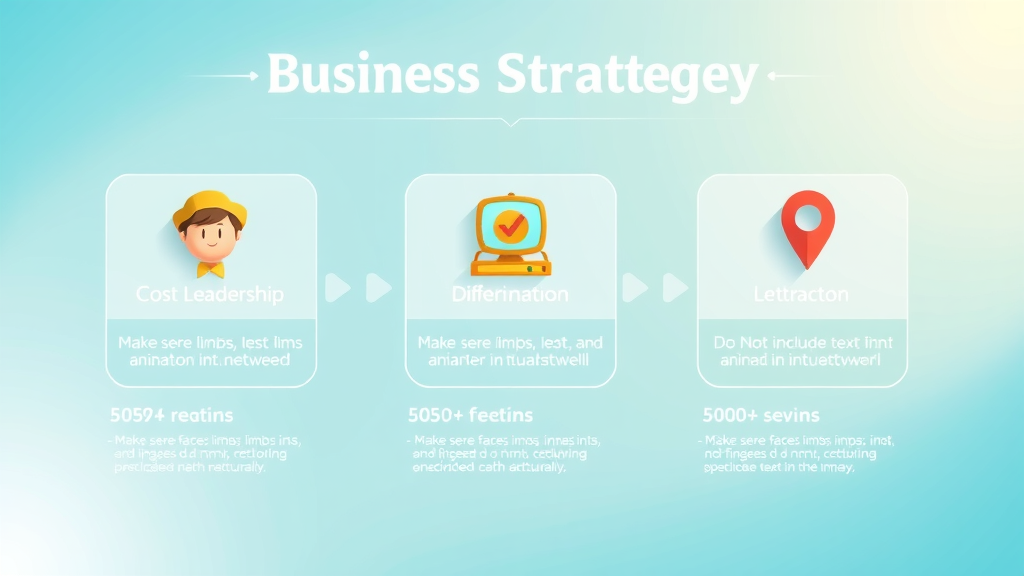Did you know that companies with an effective business strategy are 67% more likely to report growth rates above their industry’s average ? In a landscape where competition is fiercer than ever, embracing a top business strategy separates industry leaders from those struggling to keep up. Whether you're a startup founder or a corporate executive, understanding proven methods and applying real-world insights will supercharge your path to market dominance. This guide reveals not just the theory but the strategies you can apply today to deliver immediate and sustainable results.
Discover the Power of Top Business Strategy: Startling Success Rates That Change the Game
Implementing a top business strategy isn’t just about planning; it’s about unleashing rapid growth and securing a competitive edge that lasts. According to Harvard Business Review, businesses with a clearly defined and executed strategic plan grow twice as fast as their competitors. These successful business strategies are data-driven and deeply rooted in understanding market trends, customer needs, and disruptive innovation.
For example, consider how tech giants like Apple and Amazon consistently outpace their peers—not through luck, but through committed, strategic planning and analysis. By focusing resources on what drives the highest value, these organizations turn insights into action to claim larger market share and higher profits.
- You’ll learn how cutting-edge business strategies, data-driven strategic planning, and effective business tactics can transform your organization’s growth trajectory.

Why a Top Business Strategy Matters for Every Organization
Every organization—regardless of size or industry—faces obstacles when it comes to sustainable growth and long-term success. The absence of a top business strategy can result in stagnation, missed opportunities, and diminished returns. A successful business strategy provides focus, aligns resources, and guides decision-making towards the organizational goals that truly matter. It transforms vision into reality and ensures that each business unit operates synergistically rather than in silos.
Unlike ordinary or generic approaches, an effective business strategy turns vague aspirations into actionable steps. It sets measurable targets, outlines responsibilities, and introduces monitoring systems—ensuring the entire organization works toward the same objectives. Organizations with a strong strategic plan not only survive changing markets but often emerge as industry pioneers.
The Essential Difference Between Top Business Strategy and Ordinary Approaches
It’s easy to assume any plan can drive success, but top business strategies go far beyond the routine. Where an ordinary business plan may list products or services and revenue goals, a powerful strategy weaves together market intelligence, SWOT analysis , and relentless focus on competitive advantage. This approach is rooted in data and flexibility, adapting to a dynamic competitive landscape instead of being reactive.
Organizations embracing a top business strategy stay ahead by being proactive—anticipating shifts in customer needs, tweaking their business models, and allocating resources where they have the most impact. Such strategic planning fosters an environment of innovation, employee engagement, and continuous improvement, enabling sustained growth despite industry disruptions.
"A strategic plan doesn’t guarantee success—being at the top of your business strategy game does."
Key Components of Effective Business Strategies in Modern Markets
A successful business strategy is a blend of art and science, combining visionary leadership with robust analytics. At its core, effective business strategies align people, processes, and technology to steer the company ahead. In today’s fast-paced market, key components such as SWOT analysis , competitive positioning, and data-driven decision-making are essential.
Modern strategic planning incorporates customer feedback, tracks performance using clear KPIs , and regularly reviews progress toward achieving competitive advantage. Crafting strategies for long-term aims requires leaders to identify and nurture what makes their organization unique—a compelling value proposition, a commitment to quality, and the flexibility to pivot as market needs shift.

Strategic Planning: Foundation for an Evergreen Business Strategy
Effective strategic planning forms the cornerstone of any top business strategy. This process defines a company’s direction, sets achievable objectives, and benchmarks progress. It’s not a one-time event but a living framework that guides ongoing decisions and inspires the entire organization.
By conducting regular SWOT analyses and incorporating stakeholder insights, organizations ensure that their strategic plan aligns with both internal capabilities and external opportunities. Strategic planning also embeds a culture of accountability—each department and business unit understands its role in delivering the broader vision.
Formulating a Winning Strategic Plan: Core Elements and Best Practices
A winning strategic plan encompasses clear vision and mission statements, targeted objectives, market positioning, and a well-defined route for resource allocation. Best practices include involving cross-functional teams in the planning process and integrating data analytics to validate assumptions.
Business leaders should prioritize flexibility within the strategic plan to adapt to market volatility. Regular check-ins and data reviews ensure initiatives stay on track and can be adjusted rapidly, boosting a company’s resilience and competitive edge. In an era where change is constant, companies that consistently revisit their strategy set themselves apart as industry innovators.
| Aspect | Traditional Business Strategy | Top Business Strategy |
|---|---|---|
| Speed of Market Response | Slow, reactive | Fast, proactive, adaptable |
| Data Utilization | Limited, historical data only | Data-driven, real-time analytics |
| Alignment Across Business Units | Occasional, siloed | Frequent, holistic |
| Customer Loyalty & Retention | Inconsistent | Central to all initiatives |
| Growth Outcomes | Incremental, short-term | Exponential, sustained long term |
How to Build a Top Business Strategy: Step-by-Step Blueprint
For organizations aiming to create a top business strategy , a structured approach is key. The following blueprint is designed to help your leadership team clarify direction, optimize resources, and set your company up for rapid, sustainable growth. Start with a rigorous SWOT analysis to assess strengths, weaknesses, opportunities, and threats. Then, align your business plan with strategic objectives to ensure everyone is working toward the same targets.
Dive deep into market analysis to understand evolving customer needs, shifting competitive landscapes, and emerging opportunities for innovation. Carefully position your products or services for maximum impact, and invest in technology that supports strategic priorities. Throughout this process, document each step and measure progress with well-defined KPIs to foster accountability and transparency across your organization.
- SWOT Analysis for Strategic Planning
- Aligning Business Plan with Strategic Objectives
- Market Analysis and Product or Service Positioning

Case Study: How a World-Leading Company Achieved Sustainable Competitive Advantage
Consider the growth journey of Starbucks , a world example of strategic excellence. In the early 2000s, Starbucks used comprehensive SWOT analysis to identify both new product or service opportunities and looming threats from competitors. They realigned their business plan to prioritize operational efficiency, high-quality customer experiences, and innovative digital loyalty programs.
Strategic planning allowed Starbucks to rapidly adapt—launching mobile ordering ahead of market demand and customizing store formats to better fit regional preferences. This not only reinforced customer loyalty but also gave Starbucks a lasting competitive advantage , resulting in market share gains and consistent long-term growth even amidst economic downturns.
Types of Top Business Strategy: Choosing the Right Fit
Not all strategies fit every organization. Selecting the right business strategy means considering your market position, the needs of your customer base, and your internal resources. The most effective business strategies typically fall into three major categories: cost leadership , focus strategy , and differentiation . Each offers a unique route to gaining a competitive edge and increasing market share .
Evaluating the competitive landscape and identifying the strengths of your current business model is crucial before making a selection. The right business strategy aligns with your core competencies while addressing specific customer and market demands for your product or service.

Cost Leadership: Becoming a Cost Leader in Your Market
The cost leadership approach involves becoming the lowest-cost producer in your industry—without sacrificing quality. Companies leveraging this strategy focus on optimizing operations, maximizing supply chain efficiencies, and scaling up production to spread fixed costs across higher output volumes. This enables them to offer competitive prices, attract price-sensitive customers, and expand their customer base.
Achieving true cost leader status requires sustained investment in process innovation and strict cost control. For instance, Walmart’s relentless focus on operational efficiency and supplier negotiations allows it to outmaneuver competitors and continually deliver lower prices. This way, cost leaders often capture significant market share and build strong defense against competitors entering the space.

Focus Strategy: Niche Dominance and Customer Loyalty
A focus strategy targets a specific market niche, serving the unique needs of a well-defined customer segment better than anyone else. This approach allows companies to deeply understand and anticipate the preferences of their target market, creating specialized products or services that foster strong customer loyalty.
Brands like Rolex and Ferrari exemplify the focus strategy by exclusively targeting luxury consumers and tailoring their offerings and messaging accordingly. Their deep focus enables sharper marketing, higher perceived value, and unwavering loyalty. By understanding core customer values, organizations employing this strategy can develop a long-term competitive advantage that’s hard for more generalized rivals to replicate.
Differentiation Strategy: Stand Out with Unique Business Strategies
The differentiation strategy revolves around offering a unique product or service with characteristics that specifically appeal to your target market. This can involve design, quality, innovation, or specialized features that justify a higher price point. Unlike cost leaders who compete mainly on price, differentiators win by being seen as distinctive, memorable, and high value.
Apple’s relentless drive for innovation in technology and user experience shows how differentiation leads to customer loyalty and higher market share. Customers often willingly pay a premium, confident that what they are receiving is unlike anything else on the market. To succeed, companies must continuously invest in R&D, brand equity, and exceptional customer service.
| Strategy Type | Description | Goal | Real-World Example |
|---|---|---|---|
| Cost Leadership | Achieving the lowest operational costs in the industry | Increase market share through competitive pricing | Walmart, McDonald’s |
| Focus Strategy | Specializing in a well-defined market niche | Build strong customer loyalty, dominate niche | Rolex, Ferrari |
| Differentiation | Offering a unique product or service | Charge a higher price and enhance brand loyalty | Apple, Tesla |
Strategy Examples: Inspiration from Successful Business Leaders
Modeling your organization after world examples of strategic excellence can offer fresh perspective and underscore the power of a top business strategy. Business leaders like Satya Nadella (Microsoft) and Indra Nooyi (PepsiCo) transformed their companies by rethinking their corporate strategy , investing in innovation, and maintaining agility in the face of disruption.
Whether it’s leveraging digital transformation, pursuing sustainability initiatives, or entering new international markets, these strategy examples demonstrate that calculated risk-taking, grounded in data and customer-centric principles, pays off with exponential growth and enduring relevance.

World Examples of Effective Business Strategies in Action
Netflix serves as a prime example of a company that consistently adapts its business strategy to maintain a leading market position. Starting as a DVD rental service, Netflix reinvented its entire business model in response to streaming trends, focusing on technology, user experience, and global expansion.
Their data-driven approach offered personalized content recommendations, while strategic investments in original programming fueled international growth and high levels of customer loyalty. Each pivot was a result of careful strategic planning, ensuring Netflix remained at the forefront of the entertainment industry.
How Strategic Planning Enables Long-Term Corporate Strategy
Long-term success relies on the balance between ambitious vision and systematic execution. Strategic planning underpins all corporate strategy pursuits by aligning leadership goals with everyday operations. Through periodic reviews, real-time analytics, and course corrections, organizations stay focused on what matters most, evolving alongside industry and economic shifts.
For instance, Toyota’s commitment to continuous process improvement (Kaizen) has supported its position as a global leader in automotive manufacturing for decades. By linking strategic goals with operational enhancements, their business units continually deliver on both efficiency and innovation.
The Power of Customer Loyalty to Enhance Your Business Strategy
Customer loyalty isn’t just a buzzword—it’s the lifeblood of sustainable growth. Top business strategies place the customer at the center of every decision, leveraging feedback loops and loyalty programs to deepen engagement and reward repeat business.
Companies like Amazon and Southwest Airlines have redefined industries through world-class service, convenience, and reliability. The greater the emotional and functional connection with your customer base, the more insulated you are from competitive threats—even those offering a similar or lower-priced product or service.
"Your business strategy is only as strong as your commitment to executing it with precision and flexibility."
Measuring and Adapting a Successful Business Strategy
No strategy is ever perfect from the outset; ongoing analytics and adaptation are vital to unlocking the true potential of your top business strategy. To maximize results, companies must regularly monitor key performance indicators (KPIs), customer feedback, and market trends. This data-driven approach ensures resources are allocated to what works—and quickly redirected from what doesn’t.
Employing advanced tools like dashboards, CRM software, and predictive analytics enables transparent progress tracking and responsive adjustments. Champions of business strategy know when to double-down, pivot, or innovate, building a culture of experimentation and measured risk-taking across the entire organization.

KPIs and Analytics: Tracking the Impact of Your Strategic Plan
KPIs translate strategic goals into measurable results, shining a light on progress and performance gaps. Effective business strategies set specific, actionable KPIs—such as customer retention rate, revenue growth, and market share gains—tied directly to the outcomes of the strategic plan.
Regular review meetings allow executives and team leaders to discuss analytical findings, recalibrate plans, and celebrate successes. Data transparency ensures every business unit understands how their actions affect the broader corporate strategy, reinforcing shared accountability and driving momentum toward long-term objectives.
Continuous Improvement: Refining Business Strategies for Ongoing Success
Even the best business strategies demand regular refinement. Continuous improvement is built into the DNA of successful organizations, using real-time data and feedback to update tactics and stay ahead of the competition.
Organizations that institutionalize a feedback culture quickly sense emerging risks and exploit new opportunities. Their agility ensures they remain relevant in changing markets, building a sustainable competitive advantage that keeps them at the top.
Common Pitfalls in Strategy Implementation and How to Avoid Them
Even with a solid framework, execution falters when common pitfalls emerge. Many companies stumble by failing to align their corporate strategy with specific business unit goals or by treating strategic plans as static documents rather than living, adaptable guides. Overlooking customer loyalty or not building robust market feedback mechanisms can also erode potential gains.
Avoid these obstacles by ensuring all layers of the organization are involved in both planning and execution. Foster open communication, and regularly revisit your strategy to keep it current. Rigorously measure and define competitive advantage metrics to ensure every initiative is rooted in clear business value—and never neglect the evolving needs of your target market.
- Failing to align corporate strategy with business unit goals
- Overlooking the importance of a dynamic strategic plan
- Neglecting customer loyalty and market feedback mechanisms
- Undefined competitive advantage metrics

People Also Ask: Comprehensive Answers on Business Strategy
What are the 4 business strategies?
The four primary business strategies are cost leadership, differentiation, focus strategy, and diversification. Each offers a distinct path to competitive advantage by addressing different market needs, resource allocations, and core competencies.
What are the 5 P's of business strategy?
The 5 P’s of business strategy—Plan, Ploy, Pattern, Position, and Perspective—provide a framework for building, analyzing, and communicating a company’s strategic intent.
What are the 4 P's of business strategy?
The 4 P’s generally refer to Product, Price, Place, and Promotion, adapted into the context of business strategies to guide how companies create, deliver, and market value to their target audiences.
What are the 7 key components of a business strategy?
Seven key components of a business strategy include vision, mission, core values, objectives, SWOT analysis, strategic plan, and performance metrics. Integrating these ensures a holistic and executable approach.
Frequently Asked Questions about Top Business Strategy
-
How does strategic planning influence business growth?
Strategic planning sets direction and priorities. By identifying key opportunities and potential threats, organizations position themselves for steady, scalable growth while minimizing risks associated with market changes. -
What’s the difference between corporate strategy and business unit strategy?
Corporate strategy establishes overall vision and direction for a company, while business unit strategies focus on achieving specific goals within subdivisions—ensuring alignment with overarching objectives. -
Which business strategies are best for start-ups?
Start-ups typically succeed by focusing on differentiation or niche (focus strategy)—developing a unique product or service and building loyal early adopters before attempting to scale. -
How often should you revise your strategic plan?
Strategic plans should be reviewed and, if needed, updated annually or whenever significant market, organizational, or economic changes occur to remain relevant and effective.
Action Steps: Crafting and Executing Your Own Top Business Strategy
- Conduct a rigorous SWOT analysis to identify unique opportunities
- Align your business plan with organizational vision and values
- Select which business strategy aligns best with market needs
- Map a detailed execution timeline and assign clear responsibilities
- Regularly track progress and adapt the strategic plan as needed
Key Takeaways from Top Business Strategy for Rapid Growth
- Successful business strategy is data-backed and adaptable
- Strategic planning bridges vision to execution
- Competitive advantage is built on strategic differentiation and customer loyalty
Achieve Rapid Growth: Put Your Top Business Strategy into Action Today
Take the insights, tools, and frameworks shared here, and begin building your own top business strategy . Align your team, commit to continuous improvement, and start unlocking exceptional growth and value in your market.
To deepen your understanding of top business strategies, consider exploring the following resources:
- “Top Business Strategy Tips from Leading CEOs” ( industrywired.com )
This article compiles insights from prominent CEOs on effective business strategies, including leveraging data for informed decision-making and fostering adaptability to navigate market changes.
- “3 Business Strategy Examples to Inspire Your Own” ( online.hbs.edu )
This piece examines how companies like Best Buy, Nike, and Starbucks have successfully implemented business strategies to achieve growth and maintain competitive advantages.
These resources offer practical examples and expert advice to help you craft and execute a robust business strategy tailored to your organization’s goals.
 Add Row
Add Row  Add
Add 




Write A Comment